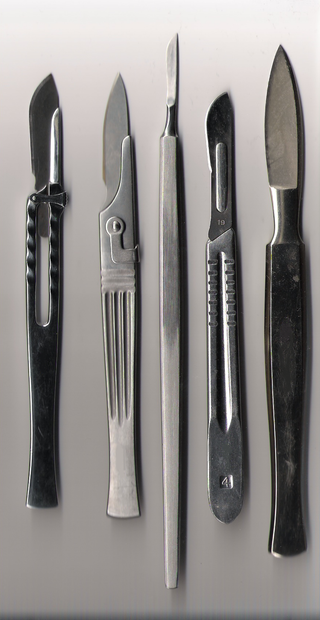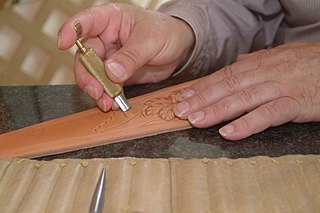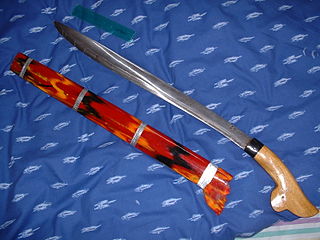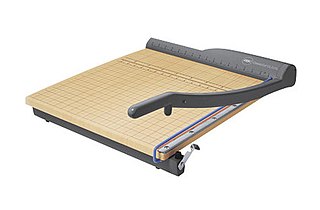
A knife is a tool or weapon with a cutting edge or blade, usually attached to a handle or hilt. One of the earliest tools used by humanity, knives appeared at least 2.5 million years ago, as evidenced by the Oldowan tools. Originally made of wood, bone, and stone, over the centuries, in step with improvements in both metallurgy and manufacturing, knife blades have been made from copper, bronze, iron, steel, ceramic, and titanium. Most modern knives have either fixed or folding blades; blade patterns and styles vary by maker and country of origin.

A chisel is a tool with a characteristically shaped cutting edge of blade on its end, for carving or cutting a hard material such as wood, stone, or metal by hand, struck with a mallet, or mechanical power. The handle and blade of some types of chisel are made of metal or of wood with a sharp edge in it.

A scythe is an agricultural hand tool for mowing grass or harvesting crops. It is historically used to cut down or reap edible grains, before the process of threshing. The scythe has been largely replaced by horse-drawn and then tractor machinery, but is still used in some areas of Europe and Asia. Reapers are bladed machines that automate the cutting of the scythe, and sometimes subsequent steps in preparing the grain or the straw or hay.

A scalpel, lancet, or bistoury is a small and extremely sharp bladed instrument used for surgery, anatomical dissection, podiatry and various arts and crafts. Scalpels may be single-use disposable or re-usable. Re-usable scalpels can have permanently attached blades that can be sharpened or, more commonly, removable single-use blades. Disposable scalpels usually have a plastic handle with an extensible blade and are used once, then the entire instrument is discarded. Scalpel blades are usually individually packed in sterile pouches but are also offered non-sterile. Double-edged scalpels are referred to as "lancets".

A blade is the portion of a tool, weapon, or machine with an edge that is designed to puncture, chop, slice or scrape surfaces or materials. Blades are typically made from materials that are harder than those they are to be used on. Historically, humans have made blades from flaking stones such as flint or obsidian, and from various metal such as copper, bronze and iron. Modern blades are often made of steel or ceramic. Blades are one of humanity's oldest tools, and continue to be used for combat, food preparation, and other purposes.

A peeler is a kitchen tool, a distinct type of kitchen knife, consisting of a metal blade with a slot with a sharp edge attached to a handle, used to remove the outer layer of some vegetables such as potatoes, broccoli stalks, and carrots, and fruits such as apples and pears. A paring knife may also be used to peel vegetables. The blade of a peeler has a slot with one side sharpened; the other side of the slot prevents the blade from cutting too far into the vegetable.

A Japanese kitchen knife is a type of a knife used for food preparation. These knives come in many different varieties and are often made using traditional Japanese blacksmithing techniques. They can be made from stainless steel, or hagane, which is the same kind of steel used to make Japanese swords. Most knives are referred to as hōchō or the variation -bōchō in compound words but can have other names including -kiri. There are four general categories used to distinguish the Japanese knife designs: handle, blade grind, steel, and construction.

A miter saw or mitre saw is a saw used to make accurate crosscuts and miters in a workpiece by positioning a mounted blade onto a board. A miter saw in its earliest form was composed of a back saw in a miter box, but in modern implementation consists of a powered circular saw that can be positioned at a variety of angles and lowered onto a board positioned against a backstop called the fence.

A kitchen knife is any knife that is intended to be used in food preparation. While much of this work can be accomplished with a few general-purpose knives – notably a large chef's knife, a tough cleaver, a small paring knife and some sort of serrated blade – there are also many specialized knives that are designed for specific tasks. Kitchen knives can be made from several different materials.
In cooking, a chef's knife, also known as a cook's knife, is a cutting tool used in food preparation. The chef's knife was originally designed primarily to slice and disjoint large cuts of beef. Today it is the primary general-utility knife for most western cooks.

A straight razor is a razor with a blade that can fold into its handle. They are also called open razors and cut-throat razors. The predecessors of the modern straight razors include bronze razors, with cutting edges and fixed handles, produced by craftsmen from Ancient Egypt during the New Kingdom. Solid gold and copper razors were also found in Ancient Egyptian tombs dating back to the 4th millennium BC.

Leather carving is the process of giving a three-dimensional appearance to leather craft objects or works of art by cutting and stamping the surface. Many different kinds of leathers can be used for these crafts.

The parang is a type of knife used across the Malay archipelago. It is often mistakenly assumed to be a sword; however, there is no evidence that it has ever been used in a formal military conflict, nor that its intended purpose was to be used as a combat weapon. Although some may argue that it could be called a machete or a chopper as it is a direct variation of the modern machete, its academic status remains as a knife.

Sharpening is the process of creating or refining the edge joining two non-coplanar faces into a converging apex, thereby creating an edge of appropriate shape on a tool or implement designed for cutting. Sharpening is done by removing material on an implement with an abrasive substance harder than the material of the implement, followed sometimes by processes to polish/hone the sharp surface to increase smoothness.

A paper cutter, also known as a paper guillotine or simply a guillotine, is a tool often found in offices and classrooms. It is designed to administer straight cuts to single sheets or large stacks of paper at once.

Knife sharpening is the process of making a knife or similar tool sharp by grinding against a hard, rough surface, typically a stone, or a flexible surface with hard particles, such as sandpaper. Additionally, a leather razor strop, or strop, is often used to straighten and polish an edge.
This glossary of woodworking lists a number of specialized terms and concepts used in woodworking, carpentry, and related disciplines.
The crooked knife sometimes referred to as a "curved knife", "carving knife," or "mocotaugan," from the Cree term "môhkotâkan," is a woodworking knife, typically with a curved end. The crooked knife is a common tool found amongst the native Americans of the Eastern Woodlands as well as non-native woodworkers. The crooked in "crooked knife" refers to its unusual shape with the handle set at an oblique angle to the blade. The blade can be straight or curved, long or short and can be made of a steel forged specifically for the knife, or from reused hardened steel from another source. The shape of the blade, whether curved or straight, is a function of the carving purpose of the user: straight for whittling wood, making splints for baskets and incising, curved for hollowing out bowls and masks and ladles, as well as myriad other usages.

Leather crafting or simply leathercraft is the practice of making leather into craft objects or works of art, using shaping techniques, coloring techniques or both.

A fillet knife is a kitchen knife used for filleting. It gives good control and aids in filleting. It is a very flexible member of the boning knife family that is used to filet and prepare fish. Fillet knife blades are typically 15 to 28 cm long. This allows them to move easily along the backbone and under the skin of meat.

















